Bogota Food Tour with La Mesa: food.. and more!
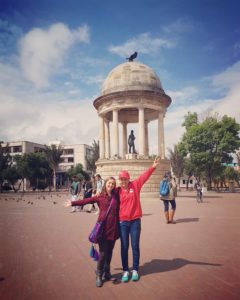
When La Mesa Food Tours invited me to join them on their Bogota food tour, I was intrigued. I’ve been living in Bogota on and off for nearly three years now, and thought I knew the essentials about Colombian food. That said, due to my sensitive stomach, I have always been wary of buying street food, so I suspected that I still had plenty to discover about Bogota’s food scene. As it turns out, I was right!
I’m going to give a run-down of what we did on the tour, and I’ll then explain why I think this tour is great value for money, especially if you’re just in Bogota for a couple of days, or if you live in Bogota and haven’t properly taken the plunge into Colombian street food!
Bogota Food Tour
The tour started promptly at 9.30am from Parque de los Periodistas in the centre of Bogota, very close to the Candelaria. Our group was greeted by our guide Margarita, and Nicole, co-founder of La Mesa Food Tours, and we were presented with our first taste of the day – a pot of mangoviche! We then headed to a nearby food-cart where we tried delicious arepas (fried pastries filled with meat, rice, egg and various other mouth-watering ingredients) and a battered egg-filled potato (papa rellena – a great vegetarian option!).
Best aromática EVER
We then proceeded onto one of my favourite parts of the tour, into a local café where we tried a home-made aromática. This is a fruity, herbal tea which is very popular in Bogota’s chilly climate. We were allowed to go behind the counter so that we could see what was going on, and I was fascinated to see the effort that went into the process of preparing the aromática. All the while, Margarita was explaining the process to us and was happy to translate any explanations that the lady from the shop gave about what she was doing. This was – hands down – the tastiest aromática I’ve ever tried; such a wonderful combination of fruits and herbs – it didn’t even need any sugar!
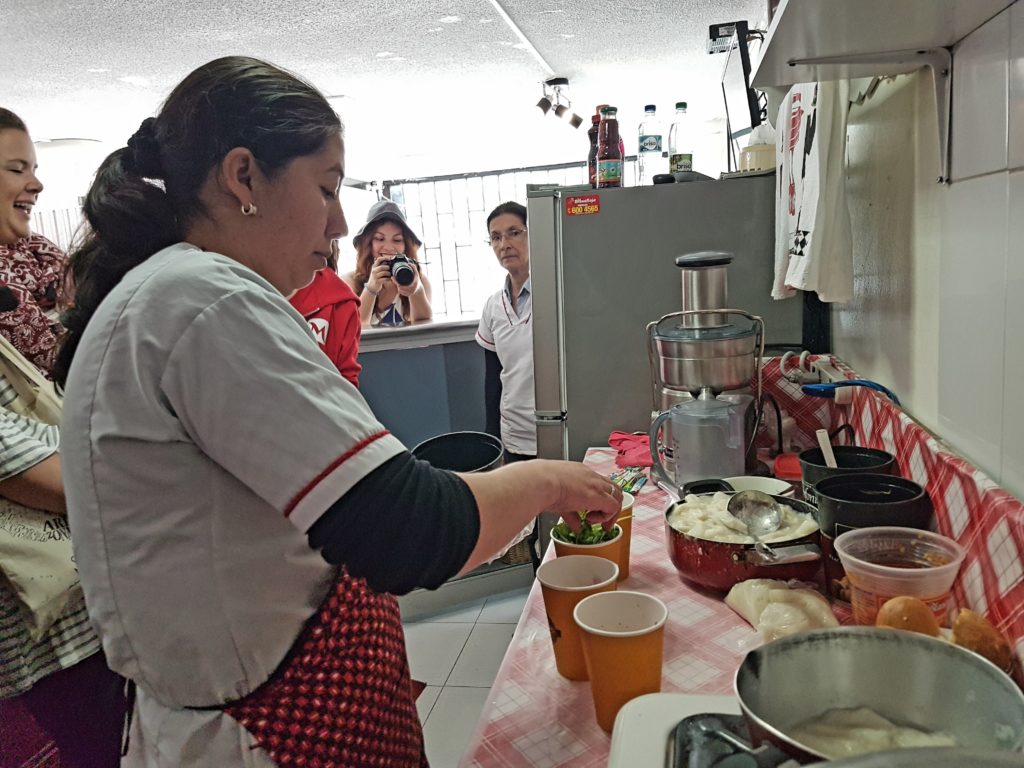
We were fascinated to see how the aromática was prepared
The tour continued to a local shop which was selling more typical Colombian street food. There we tried pastel de yuca (a kind of cake-y slice containing yucca), which I had never tried before. This was probably my favourite taster from the whole tour, and I was so delighted to find something so simple and yet so tasty that I’d never have thought of trying.
More than just a food tour
As we went on, we would stop occasionally and Margarita would talk to us about the street art and monuments around us, and relate these to important Colombian historical figures and events. I learned a number of things about Colombian culture and history on this tour that I don’t think I would have thought to find out about otherwise.
Right to the heart of Colombian food
During this tour we had time to sit down, relax and ask questions about the different food and drink that we were trying. We tried a specially-prepared Colombian hot chocolate, then moved on to try chicha (also known as ‘indigenous beer’ – a fermented corn and honey drink which does taste a little bit like beer) and ajiaco (see my other post on how to eat ajiaco, for more information about this soupy dish!). Many of the dishes and drinks that you try on this tour have a story behind them – where do they originate from? How did these dishes emerge, and what were the cross-cultural influences? Margarita gave an informative and interesting running commentary as we devoured what she gave us, which really added to the whole experience.
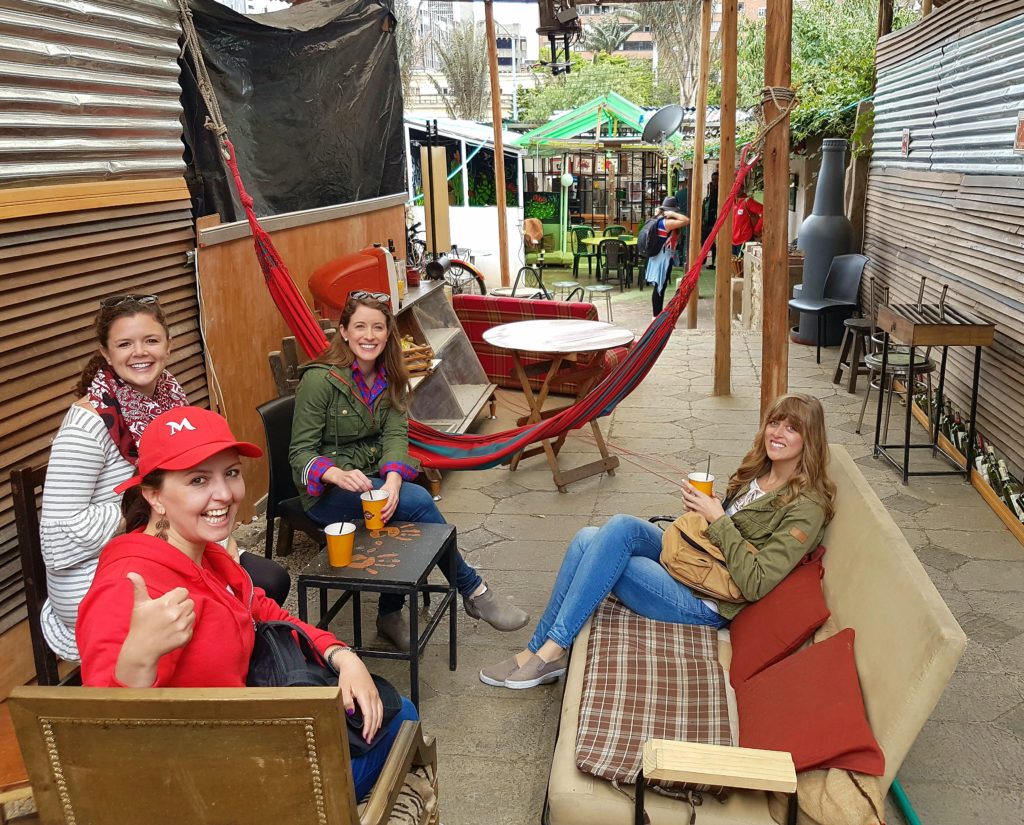
We took some time to sit down and enjoy our aromática, while our next treat was being prepared!
Tutti Frutti
Forgive the slip into Italian, but never was a phrase so fitting to a country as it is to Colombia. The first time I walked into a Colombian supermarket, my jaw dropped as I wandered in a daze through the fruit and vegetable section. In Colombia, even the most seasoned of travellers will come across at least one fruit that they don’t recognise; the variety is just staggering (particularly to an English girl raised on apples, bananas and oranges)!
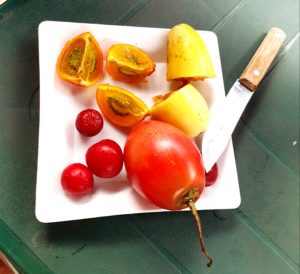
I think it’s fair to say that for many people who take this tour, the typical Colombian fruit tasting will be one of the highlights. Not only will you be able to try the fruit juices – which you’ll find served in most food places all over Colombia – you’ll also be able to try the raw fruits. I really enjoyed being able to do this, as it’s easy enough to order a lulo juice, but how often would you go into a supermarket and buy a single lulo just to try? I never had!
A sweet and ‘savoury’ finish
We strolled through the enchanting neighbourhood of the Candelaria, the oldest part of Bogotá, stopping to eat and drink as we went. Margarita pointed out and talked about some of the stunning pieces of street art/graffiti that we passed along the way, which might leave you feeling eager to find out more. If so, I’d really recommend doing the Bogota Graffiti Tour!
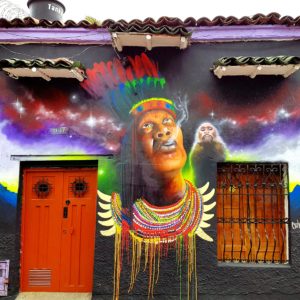
There is plenty of stunning street art to admire as you walk through the Candelaria.
For dessert, we were treated to a delicious oblea, a wafer smoothed in arequipe (caramel spread), jam and however many other sweet delights you wish to toss in there! As we chewed, Margarita told us the story behind the oldest restaurant in Bogotá, which was just behind us, before she led us over to the finishing line at Plaza Simón Bolivar and presented us with a parting gift: hormigas culonas (‘big-arsed ants’ – a ‘delicacy’ from Santander). Now, I’d heard about hormigas culonas before. I had seen them being sold, and I’d been dared on numerous occasions to try one by Javi, my Colombian other half. I had laughed in his face and told him he was hilarious, and that no; no way and no how was I putting one of those things in my mouth. But Margarita and Nicole were pretty persuasive, so for the pure entertainment value, I decided to give it a try with my friend Emily.
I don’t think I’ll comment too much on that experience here, as I think this video (and my face) says it all!
Verdict
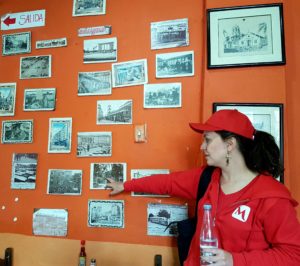
Margarita talked us through some old photos of Bogotá from the middle of the last century.
As someone who has already lived in Colombia for a while, and eaten much of the food, this food tour nevertheless exceeded my expectations. It’s worth repeating that this is so much more than just a food tour; I learned facts about Colombian history and culture, explored parts of the Candelaria neighbourhood that I had never ventured through before, and I filled up on a wide variety of Colombian food and drink, some of which I had never tried before. On this tour, you don’t just eat the food, you sample an important aspect of Colombian culture and learn about the stories behind what you’re consuming.
You might not like everything you try on the tour (I wasn’t a huge fan of chicha (indigenous beer), and the phrase ‘never again’ springs to mind when I think of hormigas culonas!). But part of experiencing the culture and cuisine of another country means trying things you never thought you’d try.
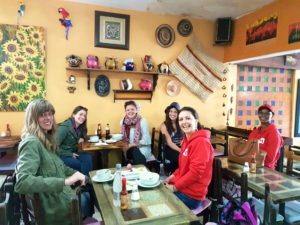
We enjoyed tucking into our ajiaco, washed down by a cold beer!
Value for money?
The cost of the three-hour Bogota food tour is $49 USD for adults and $18 USD for children aged 7 – 13. Once I realised everything this tour actually offers, beyond the food on your plate, the price actually seems reasonable.
You get an introduction to all kinds of food and drink that you wouldn’t know to ask for if you’re new (or even not so new!) to Colombia; a knowledgeable local bilingual guide who will tell you all about the history and culture behind what you’re eating and what you’re seeing as you go from place to place; a walking tour of the centre of Bogota and the Candelaria spread over three hours, and a full belly at the end. So all in all, I think this ends up being good value for money. This tour gives you a great experience of Bogotá, and is worth doing if you’re just in Bogota for a couple of days, or equally if you’ve lived here a while and feel like you still have more to learn about Bogota and its cuisine.
For more information and to book a tour, visit the Bogota Street Food Tour page of La Mesa’s website.
One piece of advice: save a piece of your deliciously sweet oblea to finish AFTER you’ve tried the big-arsed ant!
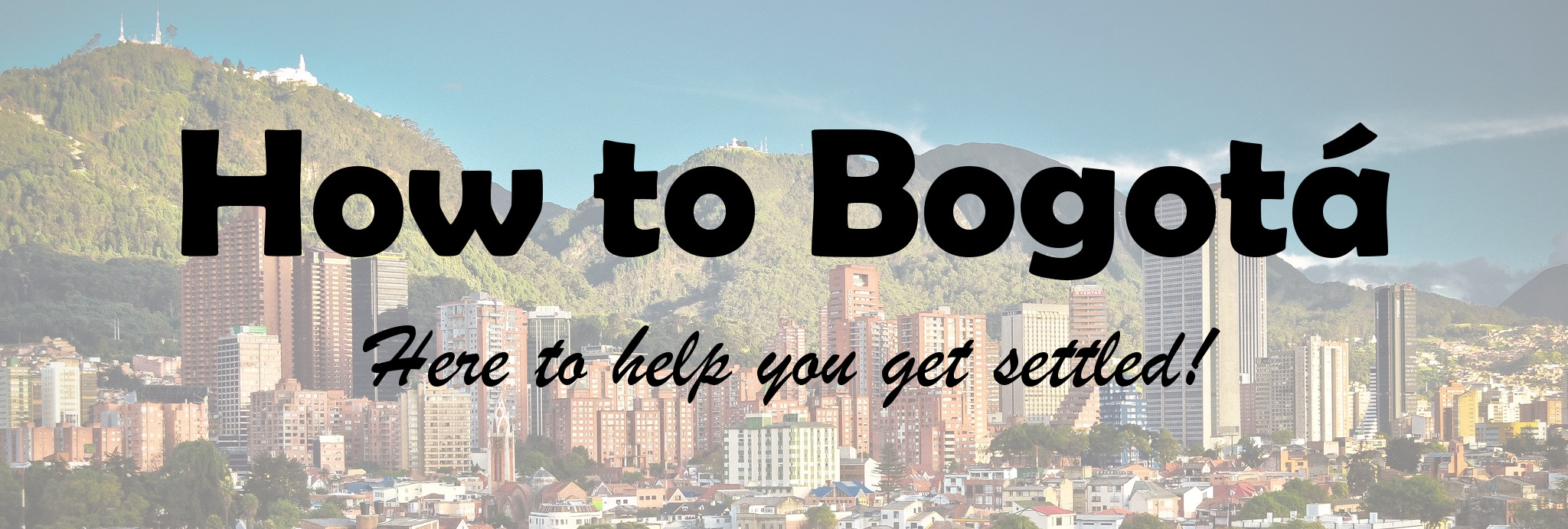



Leave a comment